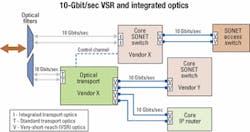Practices for cost-effectively scaling optical networks
Can you say, 'Maximum revenues through optimization of existing infrastructure?'
ROBERT WARD, Williams CommunicationsThe evolution of optical networks has made for interesting design shifts in both transport and switching architectures. Due to several anticipated technology innovations, we are likely in for another twist in the near future. Carriers must be nimble so they can adjust and take advantage of these technology trends and innovations. Significant cost reductions typically will not appear in the form of simple hardware or software changes. In most cases, they will require involved architectural tradeoffs and decisions.
Developing a scalable network goes beyond providing capacity and port availability. It's objective is to make optimal use of existing infrastructure and drive maximum revenue from a given system, architecture, and operational budget. Common techniques are being used or considered in developing elegant scaling strategies.
Transport systems
Optical transport systems have long been a dominating element of long-haul (LH) carriers' cost structures and thus have been a primary target for technological advances that would potentially transform the cost curve. As part of this effort, optical-electrical-optical (OEO) conversions have been identified as a key cost component.
Due to common transport technologies deployed in the 1990s, these OEO conversions typically increase with circuit length and system capacity. New developments have made significant progress toward decoupling circuit length and capacity from OEO conversion requirements, while increasing overall capacity on single amplifier systems.
Erbium-doped fiber-amplifier (EDFA) systems have been common among terrestrial LH networks, but the system design eventually became limiting for both system capacity and growth strategies. First, the EDFA spectrum had been optimized for wavelength amplification in either the C-band (1528-1560 nm) or L-band (1570-1605 nm), which led to development efforts to squeeze more channels into these fixed spectrums. Second, optical link budgets generally required OEO regeneration after four to five consecutive 20-dB amplified spans, corresponding to a 400-km distance between regenerators. Because OEO regeneration is performed discretely, as optical channels were added to the system, per-channel regeneration modules were required every 400 km to maintain signal integrity.These equipment costs are often more evident. However, operational processes and maintenance records became excessively complicated by the continual addition of electronics at regenerator sites and central offices.
Advances in Raman amplification for 1500- and 1600-nm transmission has spurred development in all transmission areas, including EDFAs, and enabled carriers to scale transport relatively independent of circuit length. Raman amplification uses the transmission fiber as the gain medium, or distributed amplification, which combats fiber attenuation and ultimately improves optical signal-to-noise ratio (OSNR).
When implemented properly, this technology can enable dramatic increases in transmission distance without OEO regeneration, leading to less distance-sensitive cost structures. Realistically, that means the turn-up of a single channel requires the addition of only two OEO interfaces: one at circuit ingress and one at circuit egress. From an operational standpoint, only two additional interfaces must be spared, monitored, and maintained for each channel added to the system, independent of the circuit's length.
Raman amplifiers are also inherently more modular.
Raman relies on pump lasers of varying frequency to provide amplification across the entire spectrum, as opposed to banded EDFA designs (C-band amp, L-band amp). That potentially allows for a very modular and incremental scaling strategy.Today, many variants of ultra-long-haul technology exist that use Raman amplification. Some operate in a pure Raman environment, while others use hybrid Raman/EDFA architectures.
Transport systems generally have seen a 10X increase in channel density since 1998 and will likely see moderate increases in the years to come. Increasing system capacity allows carriers to scale networks with interfaces alone, making optimal use of existing line amplifiers and common equipment.
Due to advancements in modulation techniques, filter technology, and laser stability, systems can now reduce the frequency spacing between optical channels-ultimately leading to increased channel density within a given spectrum (see Figure 1). The industry has moved from 200-GHz spacing for 10-Gbit/sec channels in 1998 to today's readily available 50-GHz-spaced systems and sparsely available 25-GHz-spaced systems. Denser channel loading optimizes amplifier use, and having the ability to distribute installation, fiber, and amplifier costs across a 25-GHz-spaced system reduces overall cost per bit.
Systems using standard modulation techniques are able to fit up to 80 10-Gbit/sec channels into a single band (C- or L-band), while advanced modulation implementations are yielding upwards of 120 10-Gbit/sec equivalents within a standard band. Many of these advanced modulation schemes are very mature techniques taken from wireless communications and adapted for optical transmission. Many techniques based on subcarrier multiplexing modulation increases the potential capacity of a given bandwidth segment over a typical on/off keyed modulation scheme and ultimately makes more optimal use of the line amplifiers.
Switching architectures
Scaling a core optical network is a complex task involving much more than transport capacity and switch port additions. A scaling architecture must be chosen fairly early in the development cycle to avoid growing into an enormously complex network while still providing restorable services in a ubiquitous manner.
There are numerous products participating in the core switching space, from STS-1 (52-Mbit/sec)-level TDM and packet switching nodes to STS-48 (2.5-Gbit/sec)-granularity switches to wavelength and waveband photonic switches. All have distinct benefits, but they also have specific restrictions and qualifications to follow for optimal use.
Development of an STS-1-based grooming platform is generally a fixed requirement for LH carriers today. However, this platform will function as part of the core in some networks, while relegated to edge grooming in others. Despite the perceived shift toward 2.5- and 10-Gbit/sec wave demand, carriers still see a dominating majority of traffic purchased at sub-OC-48 (2.5-Gbit/sec) levels and therefore must have an efficient mechanism for scaling the network with this service demand.An STS-1 switch functioning in the core allows efficient packing of wavelengths at circuit ingress as well as at intermediate switch nodes. In practical terms, that means switching elements are able to share common bandwidth and network capacity additions come in incremental rations. In contrast, a pure wavelength or STS-48 switching core requires trunks dedicated to each city-pair combination; as network growth is needed, the augmentation is carried out in the same bulk manner.
Despite this consideration for growth, higher-granularity switches have essential roles in scaling the network. In the future, these switches will likely function as the upper tier of a two-tier switch architecture, with a lower-level switch functioning as the grooming layer or the lower tier. STS-1 switches are desirable when initiating a core design. But for the same reasons they are desirable, they are not ideal over the long term, as circuit size increases and the network grows.
Intermediate grooming requires intermediate ports, and although that proves to be efficient for a portion of traffic, it would also make sense to minimize intermediate ports wherever possible. Bypassing intermediate switches and minimizing port count would ultimately fall to the larger switches operating at wavelength and waveband levels (see Figure 2).
Scalability requirements (approximately hundreds of terabits per second) for this second switching tier will be challenging for electrical-based fabrics that will likely face many of the same challenges as STS-1-based electrical fabrics. Nodes capable of switching hundreds of terabits per second cannot rely on distinct interfaces for each channel-and some photonic systems have incorporated this notion in their design.
Developing "bulk" ports, each capable of bearing multiple channels, will be critical to scaling systems in acceptable footprints. Electrical fabric switches have typically required comparable real estate for both their switch fabrics and optical interfaces. However, photonic switches have developed considerably smaller fabrics for similar capacities. Based on the functional requirements and expectations of the photonic switch, multichannel ports make both financial and architectural sense.
Integration techniques
In additional efforts to reduce interface and interconnect costs, two paths have formed among carriers and systems manufacturers: very-short-reach (VSR) interfaces and functional integration. The common goal is to reduce connection complexity and interface costs between high-rate (10- or 40-Gbit/sec) intra-office equipment requiring limited reach (<600 m). Although these two paths are not mutually exclusive, it appears many manufacturers have clearly identified priorities.
VSR is an emerging standard from the Optical Internetworking Forum for 10-Gbit/sec interfaces. However, the adoption and development by systems manufacturers has been slow and tentative. If implemented widely, carriers would be capable of interconnecting transport, switching, and routing equipment from various vendors at 10-20% cheaper than with standard 10-Gbit/sec short-reach (SR) interfaces. This reduction could not be achieved for 2.5-Gbit/sec interfaces, but the eventual 40-Gbit/sec VSR savings should be in line with or in excess of the 10-Gbit/sec interface cost reduction.
Due to the variety of implementations being pursued by different manufacturers, it may become difficult to achieve a standard within a carrier's central office. Some vendors have chosen singlemode-serial implementations, while others have opted for singlemode-parallel-two very incompatible versions. Implementations such as parallel or multimode will also require modifications to carrier intra-office infrastructure like fiber patch cords and patch panels.
Sparing of additional patch cords is likely an acceptable caveat, but the addition or conversion of patch panels from SC or LC to MTP/MPO-style connectors is not a cheap or painless procedure. At the end of the road, the addition of VSR interfaces has genuine cost reductions to be applied across equipment and vendor boundaries. Getting there will likely require an accommodating and coordinated relationship between the carrier and its vendors.
The second path is focused on the integration of transport-quality optics on switching and aggregation nodes. Typically, these network elements will connect to optical transport elements via SR interfaces, requiring two interfaces per con nection. Integrating the transport optics into the switching gear eliminates the transport interface entirely, allowing the switch's transponder to connect directly to the transport DWDM filters.
Today's LH transport systems can be very complex and are often dependent on automatic balancing algorithms; therefore, this integration is generally restricted to network elements of common heritage. Vendors will develop proprietary control and feedback mechanisms between transport and switching elements to maintain consistent operations of the systems. Although most switching and aggregation equipment offers common ITU-grid-compliant optics, the overall system would not be maintainable over long distances without the feedback and control mechanisms implemented by particular manufacturers.
Figure 3 depicts the implementation of both alternatives in a generic carrier hub. Note that vendor X's core switch is able to take advantage of integrated transport optics due to its commonality with the transport system. Vendor Y is restricted to using VSR interfaces.
The integrated implementations offered today are available for switching and aggregation systems only and for the foreseeable future will likely not include Layer 2 or Layer 3 devices. Cost reductions vary with the implementation, but integrated alternatives will typically bring a small cost reduction over VSR interfaces.
VSR is obviously very critical for carriers deploying several different vendors on their networks. The realistic implementation of VSR interfaces on carrier networks relies on several vendors developing common interfaces. Unfortunately, the collective downplay in the industry has led to very few deployable designs.
Robert Ward is chief optical architect at Williams Communications (Tulsa, OK). He can be reached via the company's Website, www.wcg.com.
References
- M.C. Wendel, R. Ward, M. Jary, "Transparent Optical Networking: Future Trends in Design and Deployment," NFOEC 2000 technical proceedings, pp 41-49.
- G.P. Agrawal, Fiber Optic Communication Systems, 2nd edition, 1997, pp. 323-3337.




